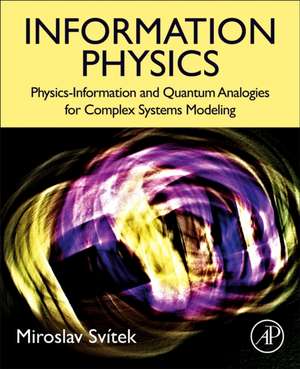Information Physics: Physics-Information and Quantum Analogies for Complex Systems Modeling
Autor Miroslav Sviteken Limba Engleză Paperback – 13 iun 2021
- Provides readers with an understanding of the analogies between very sophisticated theories of electrical circuits and currently underdeveloped information circuits, including capturing positive and negative links, as well as serial and parallel ordering of information blocks
- Integrates coverage of quantum models of complex systems using wave probabilistic functions which extend the classical probability description by phase parameters that allow researchers to model such properties as entanglement, superposition and others
- Provides readers with illustrative examples of how to use the presented theories of complex systems in specific cases such as hierarchical systems, cooperation of a team of experts, the lifecycle of the company, and the link between short and long-term memory
Preț: 803.30 lei
Preț vechi: 1010.95 lei
-21% Nou
Puncte Express: 1205
Preț estimativ în valută:
153.71€ • 160.89$ • 127.94£
153.71€ • 160.89$ • 127.94£
Carte tipărită la comandă
Livrare economică 24 martie-07 aprilie
Preluare comenzi: 021 569.72.76
Specificații
ISBN-13: 9780323910118
ISBN-10: 0323910114
Pagini: 154
Dimensiuni: 191 x 235 x 19 mm
Greutate: 0.28 kg
Editura: ELSEVIER SCIENCE
ISBN-10: 0323910114
Pagini: 154
Dimensiuni: 191 x 235 x 19 mm
Greutate: 0.28 kg
Editura: ELSEVIER SCIENCE
Cuprins
1. Introduction to Information Physics 1.1 Dynamical systems1.2 Information representation1.3 Information source and recipient1.4 Information gate1.5 Information perception1.6 Information scenarios1.7 Information channel
2. Classical Physics – Information Analogies 2.1 Electrics – information analogies 2.2 Magnetic – information analogies 2.3 Information elements2.4 Extended information elements 2.5 Information mem-elements
3. Information circuits3.1 Telematics 3.2 Brain adaptive resonance 3.3 Knowledge cycle
4. Quantum Physics - Information Analogies 4.1 Quantum events 4.2 Quantum objects 4.3 Two (non-)exclusive observers4.4 Composition of quantum objects4.5 Mixture of partial quantum information4.6 Time-varying quantum objects 4.7 Quantum information coding and decoding 4.8 Quantum data flow rate4.9 Holographic approach to phase parameters4.10 Two (non-) distinguished quantum subsystems 4.11 Quantum information gate4.12 Quantum learning
5 Features of Quantum Information 5.1 Quantization 5.2 Quantum entanglement 5.3 Quantum environment 5.4 Quantum identity 5.5 Quantum self-organization 5.6 Quantum interference 5.7 Distance between wave components 5.8 Interaction’s speed between wave components 5.9 Component strength5.10 Quantum node6. Composition rules of quantum subsystems6.1 Connected subsystems6.2 Disconnected subsystems6.3 Coexisted subsystems6.4 Symmetrically disconnected subsystems6.5 Symmetrically competing subsystems6.6 Interactions with an environment6.7 Illustrative examples
7. Applicability of quantum models7.1 Quantum processes7.2 Quantum model of hierarchical networks7.3 Time-varying quantum systems7.4 Quantum information gyrator7.5 Quantum transfer functions
8. Extended quantum models8.1 Ordering models8.2 Incremental models8.3 Inserted models}8.4 Intersectional extended models
9. Complex adaptive systems 9.1 Basic agent of smart services9.2 Smart resilient cities9.3 Intelligent transport systemts9.4 Ontology and multiagent technologies
10. Conclusion
2. Classical Physics – Information Analogies 2.1 Electrics – information analogies 2.2 Magnetic – information analogies 2.3 Information elements2.4 Extended information elements 2.5 Information mem-elements
3. Information circuits3.1 Telematics 3.2 Brain adaptive resonance 3.3 Knowledge cycle
4. Quantum Physics - Information Analogies 4.1 Quantum events 4.2 Quantum objects 4.3 Two (non-)exclusive observers4.4 Composition of quantum objects4.5 Mixture of partial quantum information4.6 Time-varying quantum objects 4.7 Quantum information coding and decoding 4.8 Quantum data flow rate4.9 Holographic approach to phase parameters4.10 Two (non-) distinguished quantum subsystems 4.11 Quantum information gate4.12 Quantum learning
5 Features of Quantum Information 5.1 Quantization 5.2 Quantum entanglement 5.3 Quantum environment 5.4 Quantum identity 5.5 Quantum self-organization 5.6 Quantum interference 5.7 Distance between wave components 5.8 Interaction’s speed between wave components 5.9 Component strength5.10 Quantum node6. Composition rules of quantum subsystems6.1 Connected subsystems6.2 Disconnected subsystems6.3 Coexisted subsystems6.4 Symmetrically disconnected subsystems6.5 Symmetrically competing subsystems6.6 Interactions with an environment6.7 Illustrative examples
7. Applicability of quantum models7.1 Quantum processes7.2 Quantum model of hierarchical networks7.3 Time-varying quantum systems7.4 Quantum information gyrator7.5 Quantum transfer functions
8. Extended quantum models8.1 Ordering models8.2 Incremental models8.3 Inserted models}8.4 Intersectional extended models
9. Complex adaptive systems 9.1 Basic agent of smart services9.2 Smart resilient cities9.3 Intelligent transport systemts9.4 Ontology and multiagent technologies
10. Conclusion
